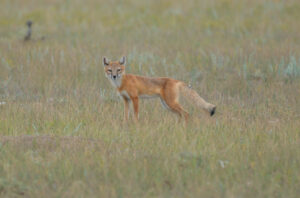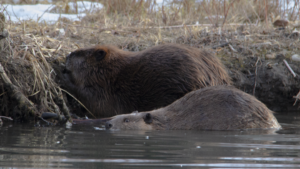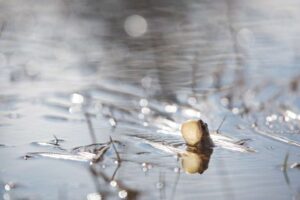by Francesca Retuta
Duckweed, also called water lentil and water lenses,14 is a subgroup of small aquatic flowering plants commonly found in nutrient-rich stagnant waterbodies, like ponds and wetlands.2,14 Most species of duckweed are free-floating and form visible green colonies over the water surface.11 They are typically confused with algae or pond scum.13 However, close inspection of duckweed would reveal that they have small leaf structures and roots.11,13
Depending on the species of duckweed, each plant consists of a few specialized leaves called fronds (typically between 1-5), and a number of root-hairs (typically between 2-4).2,5 Of the 37 known species of duckweed, 3 are commonly found in Alberta. These are the common duckweed, the ivy-leaved duckweed, and the red duckweed.8
Propagation
Despite duckweed being an angiosperm (or flowering plant),1,4 flowers, fruits, and seeds are rare.7 Duckweed typically reproduces asexually by cloning,1,7 where new buds develop near the center of existing fronds before breaking off as a new plant when mature.3,7 Duckweed reproduces quickly and can double within 2 days.3,6 They can also spread among shallow waterbodies quickly, hitching a ride on the feathers of waterfowl or the fur of small mammals.5,14
Ecosystem Functions and Other Benefits
Duckweed can benefit ecosystems in a number of different ways.
In the right amounts, duckweed is a key component in the habitat of various wildlife. Undergoing photosynthesis, duckweed contributes oxygen to its aquatic environment and to animals that require oxygen.11,13 Moreover, duckweed provides shelter for certain species of small invertebrates, amphibians, and fish.5,13
Duckweed thrives in environments rich in nutrients, such as nitrogen and phosphorus.1,5,6 As a result, they can act as a natural indicator of eutrophication,4,5,13 or the overaccumulation of nutrients in waterbodies.10 Additionally, these plants have an excellent ability to remove pollutants, such as microplastics12 and metals, in contaminated environments – a process called phytoremediation.1,4
Aside from habitat and water treatment benefits, duckweed is also considered an important source of nutrition for wildlife. As its name indicates, duckweed is a primary food source for waterfowl such as ducks and geese, but also for various fish species.1,4,9,11
Finally, scientists have been studying duckweed for other potential benefits. For one, duckweed is considered a superfood, containing about 35% carbohydrates, 20% minerals, and up to 40% protein.6 Being nutritionally comparable to soybeans,1,6 duckweed is a fast-growing alternative for livestock feed and even as food for human consumption.1,4,6,9 Some other potential applications of duckweed include alternative energy sources as biofuels,1,4 to be used in screening for toxic compounds,4,12 and as a component of bioplastics and vaccines.1
Negative Environmental Impacts
Despite its many environmental benefits and potential applications for use, duckweed can become invasive when left unchecked.
Due to their fast and efficient propagation, duckweed can easily overcome waterbodies once introduced.1,4,5 Mats of duckweed colonies can cover waterbodies and prevent sunlight from reaching other aquatic plants.11,13 Moreover, during cellular respiration (which happens during at night when plants cannot photosynthesize), duckweed can deplete the oxygen in their environments.11,13
The excess of duckweed in an aquatic system is typically a sign of excess nutrients and the lack of predators to limit duckweed growth.11,13
Summary
Duckweeds play important roles in the ecosystem, such as for water treatment and as wildlife habitat and nutrition. It also has the potential to be used as an alternative source of food, energy, and other materials. However, just as too much of anything can be negative, duckweed can also be harmful to aquatic environments in excessive amounts.
The delicate balance in ecosystems emphasizes the importance of roles played by the biotic and abiotic components of our environments. It calls us to be curious and appreciate the underlying interrelationships among plants and animals that we may often overlook.
Footnotes
- Acosta, Kenneth, Klaus Apperonth, Ljudmilla Borisjuk et al. “Return of the Lemnaceae: duckweed as a model plant system in the genomics and postgenomics era”. The Plant Cell 33, (July 2021): 3207-3234. DOI: 10.1093/plcell/koab189
- Alberta Lake Management Society. “Duckweed Lemna spp.” In Aquatic Plants of Alberta: A Collection of Native and Invasive Species, 20. Edmonton, Alberta: Jag Printing, 2016. Available online at https://alms.ca/wp-content/uploads/2016/04/ALMS-Aquatic-Plant-Book-1st-Edition-Apr-2016.pdf
- Apfel, Amelia. “How Does Duckweed Reproduce?” Sciencing. November 22, 2019. https://sciencing.com/stage-life-mitosis-occur-rapidly-17281.html
- Apperonth, Klaus, K Sree, Tamra Fakhoorian, and Eric Lam. “Resurgence of duckweed research and applications: report from the 3rd International Duckweed Conference.” Plant Molecular Biology 80, no. 6 (December 2015). DOI: 10.1007/s11103-015-0396-9
- Aquatic Biologists, inc. “Duckweed”. Aquatic Biologists, inc. Accessed on April 18, 2023. https://www.aquaticbiologists.com/duckweed
- Faculty of Bioscience Engineering, Ghent University. “Animal production systems: Sustainable feed formulations”. YouTube. April 28, 2021. https://youtu.be/LfVdi1uZ6nw
- Fourounjian, Paul, Janet Slovin, and Joachim Messing. “Flowering and Seed Production across the Lemnaceae”. International Journal of Molecular Sciences 22, no. 5 (March 2021). DOI: 10.3390/ijms22052733
- iNaturalist. “Observations: Duckweeds, Alberta”. iNaturalist. Accessed April 18, 2023. https://www.inaturalist.org/observations?place_id=6834&subview=map&taxon_id=54519&view=species
- Leng, RA, JH Stambolie, and R Bell. “Duckweed – a potential high-protein feed resource for domestic animals and fish”. Livestock Research for Rural Development 7, no. 1 (1995). Retrieved from http://www.lrrd.org/lrrd7/1/3.htm
- National Oceanic and Atmospheric Administration. “What is eutrophication?”. National Ocean Service. January 20, 2023. https://oceanservice.noaa.gov/facts/eutrophication.html
- Quinn, Sandy. “Terrestrial and Aquatic Flora: Duckweed”. Google Sites: Island Ecology 2017. Accessed April 18, 2023. https://sites.google.com/site/islandecology2017/terrestrial-flora/duckweed
- Rozman, Ula and Gabriela Kacikova. “The Response of Duckweed Lemna minor to Microplastics and Its Potential Use as a Bioindicator of Microplastic Pollution”. Plants 11, no. 21 (November 2022). DOI: 10.3390/plants11212953
- Schmidt, Lillia. “Algae and Duckweed: The Cost and Benefits”. Brandywine Conservancy. July 28, 2020. https://www.brandywine.org/conservancy/blog/algae-duckweed-costs-and-benefits
- Ungvarsky, Janine. “Duckweed”. In Salem Press Encyclopedia. Salem: Salem Press Inc., EBSCO Information Services Inc., 2021.






